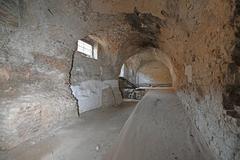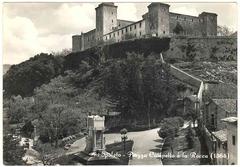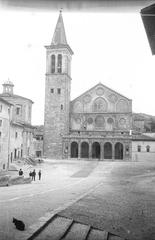Cappella Santa Caterina D'Alessandria (Monteluco Di Spoleto)
Cappella Santa Caterina d’Alessandria: Visiting Hours, Tickets, and Comprehensive Guide to Spoleto’s Sacred Heritage
Date: 14/06/2025
Introduction
Amidst the tranquil Monteluco natural reserve near Spoleto, Umbria, the Cappella Santa Caterina d’Alessandria offers visitors a deep immersion into medieval spirituality, Franciscan simplicity, and the enduring harmony between architecture and nature. This ancient chapel, dedicated to Saint Catherine of Alexandria—a symbol of wisdom and steadfast faith—stands as a monument to centuries of religious devotion and contemplative retreat. Once a sacred mountain for pre-Christian hermits and later a haven for the followers of Saint Francis of Assisi, Monteluco remains a place where spiritual and natural beauty intertwine.
This guide offers a detailed overview of the chapel’s history, art, and architectural features, alongside practical information on visiting hours, tickets, accessibility, guided tours, and nearby attractions. Whether your interest lies in sacred art, spiritual pilgrimage, or exploring Umbria’s storied landscapes, the Cappella Santa Caterina d’Alessandria provides a uniquely enriching experience. For updated details and in-depth resources, consult official tourism platforms (Umbria Tourism) and Franciscan heritage sites (Assisi OFM).
Contents
- Origins and Early History
- Architectural Features
- Religious and Cultural Significance
- Notable Events and Figures
- Artistic Heritage
- Preservation and Contemporary Relevance
- Visiting Information
- Visiting Hours
- Tickets and Admission
- Accessibility
- Guided Tours and Tips
- Nearby Attractions
- Frequently Asked Questions (FAQ)
- Conclusion
- References
Origins and Early History
The Cappella Santa Caterina d’Alessandria is rooted in the spiritual landscape of Monteluco, a mountain historically viewed as sacred. The area’s sanctity dates to antiquity, with its ancient woods preserved by the Lex Luci Spoletina, an early forest protection law (source). In the early Middle Ages, Syrian hermits established Christian eremitic life on Monteluco, laying the groundwork for the Franciscan community that would flourish after Saint Francis of Assisi’s arrival in 1218 (source).
The chapel itself likely dates from the late 13th to early 14th centuries, part of a wave of sanctuaries dedicated to saints exemplifying wisdom and martyrdom—ideals embodied by Saint Catherine of Alexandria. The modest oratory became the spiritual heart of the hermitage, reflecting both ancient eremitic practices and the Franciscan ideals of poverty, humility, and retreat (source).
Architectural Features
Built from local limestone, the chapel’s exterior is humble yet harmonious with its woodland surroundings. Its façade features a simple arched doorway and a small oculus, evoking Romanesque and early Gothic influences. The interior consists of a single nave with a barrel-vaulted ceiling and a plain stone altar, offering a contemplative atmosphere enhanced by filtered light and the quietude of the surrounding woods (source).
Surrounding the chapel are seven tiny cells (cellette), traditionally attributed to Saint Francis and his companions. These austere spaces, built with the simplest materials, symbolize the Franciscan embrace of poverty and spiritual focus. The Pozzo di San Francesco, a stone well in the courtyard, is steeped in legend, believed to have been miraculously revealed by Saint Francis (source).
Other structures in the complex include the Chapel of San Bernardino and the Oratory of Sant’Antonio da Padova, each supporting the sanctuary’s spiritual mission and architectural simplicity (source).
Religious and Cultural Significance
The dedication to Saint Catherine of Alexandria—a martyr celebrated for her intellect and steadfastness—underscores the chapel’s role as a site of pilgrimage, prayer, and reflection. Monteluco’s spiritual legacy, blending pre-Christian, eremitic, and Franciscan traditions, makes it an enduring destination for those seeking solace and inspiration (source).
Liturgical celebrations, especially the feast day of Saint Catherine on November 25, are marked by special Masses and processions. The chapel has long drawn pilgrims, hermits, and lay visitors, contributing to Monteluco’s reputation as a sanctuary of peace and contemplation (source).
Notable Events and Figures
Monteluco’s hermitage was visited by Saint Francis of Assisi and became a hub for Franciscan reform in the 14th and 15th centuries, notably under Paoluccio Trinci and Saint Bernardino of Siena. The sanctuary’s spiritual heritage has been enriched by the presence and relics of numerous Franciscan figures, including beato Leopoldo da Gaiche, who played a key role in its renewal (source).
Over the centuries, benefactors from the region supported the chapel, ensuring its maintenance and the continuation of its liturgical life. Restoration efforts in recent decades have preserved its historical and spiritual character (source).
Artistic Heritage
Though modest, the chapel and hermitage contain devotional art reflecting local Franciscan and Umbrian traditions. Fresco remnants, icons, and relics—such as those donated by Pope Urban VIII—enrich the sacred ambiance. The artistic program, defined by simplicity and clarity, provides insight into medieval religious sensibilities (source). Comparisons with other Italian sites dedicated to Saint Catherine, such as the basilicas in Galatina and Palermo, highlight the diversity of her veneration (source).
Preservation and Contemporary Relevance
Today, the Cappella Santa Caterina d’Alessandria is a living monument, maintained by the Franciscan community and local heritage organizations. Preservation efforts focus on structural stability, conservation of artworks, and enhancing visitor understanding. The sanctuary remains open for prayer, individual retreats, and guided tours, balancing its spiritual purpose with responsible tourism (source).
Visiting Information
Visiting Hours
- Standard Hours: 9:00 AM – 6:00 PM daily (may vary by season or during religious events).
- Best Times: Spring and autumn for mild weather and fewer crowds; special events on the feast of Saint Catherine (November 25).
Tickets and Admission
- Entrance: Free (donations welcomed for maintenance).
- Guided Tours: Often available through local tour operators or by arrangement with the Franciscan community; some tours may have a small fee (source).
Accessibility
- The approach includes uneven woodland paths and some steps; partial accessibility for visitors with mobility challenges. Inquiries in advance are recommended for special assistance.
Visitor Tips
- Dress modestly (shoulders and knees covered).
- Maintain silence and respect in chapels and monastic areas.
- Wear comfortable shoes for natural trails.
- Basic restroom facilities and parking are available; bring water and snacks as there are no cafés onsite.
- Photography is permitted in exterior and main church areas, but restricted in chapels and cells—request permission as needed.
Getting There
- By Car: 15 minutes from Spoleto; parking available near the sanctuary.
- On Foot: Scenic hiking trails from Spoleto, taking 1–2 hours through the oak woods.
- By Public Transport: Local buses run from Spoleto; taxis are also an option.
Nearby Attractions
- Spoleto: Explore the Duomo, Rocca Albornoziana, Roman Theater, and vibrant old town (source).
- Sacred Wood of Monteluco: Ancient oak forest with walking trails and panoramic viewpoints.
- Other Hermitages: Remnants of early Christian and Franciscan retreats dot the mountainside.
Frequently Asked Questions (FAQ)
Q: What are the Cappella Santa Caterina visiting hours?
A: Typically 9:00 AM to 6:00 PM daily, but check ahead for seasonal changes and special closures.
Q: Is there an entrance fee?
A: No, entrance is free, though donations are appreciated.
Q: Are guided tours available?
A: Yes, through the Franciscan community or local tour operators; advance booking is advised.
Q: Is the site accessible for people with limited mobility?
A: Partial accessibility; the main areas are more accessible than the ancient cells and chapels.
Q: When is the best time to visit?
A: Spring and autumn are ideal for weather and scenery; major religious festivities offer unique experiences.
Q: Can I attend religious services?
A: Yes, Masses and other services are held regularly, particularly on feast days.
Conclusion
The Cappella Santa Caterina d’Alessandria stands as a serene testament to centuries of faith, Franciscan heritage, and the enduring allure of Umbria’s sacred landscapes. Visitors are welcomed into a space where history, spirituality, and nature converge—whether for pilgrimage, cultural exploration, or quiet reflection. Thoughtful preservation and accessible visitor amenities ensure that the chapel remains a living site of community and contemplation. To fully appreciate your visit, consult local resources, arrange guided tours, and leverage dedicated travel apps for up-to-date information.
Plan your journey to Monteluco and experience the timeless spirit of Cappella Santa Caterina d’Alessandria. For ongoing updates, download the Audiala app, and explore related articles on Spoleto’s historical sites and Franciscan heritage.
References
- Basilica di Santa Caterina d’Alessandria in Galatina
- Monteluco: Il bosco sacro e l’eremo di San Francesco
- Santuario di San Francesco (Monteluco)
- Eremo e Convento di Monteluco Spoleto
- Santa Caterina d’Alessandria Church in Palermo
- Umbria Tourism: Eremo di San Francesco
- Assisi OFM: San Francesco Monteluco
- Key to Umbria: S. Francesco di Monteluco
- Fonte Cesia: The Sacred Woods of Monteluco
- I Luoghi del Silenzio: Cappella di Santa Caterina d’Alessandria Monteluco di Spoleto
- SISPO Centro: Il Santuario di San Francesco in Monteluco di Spoleto
- Katy in Umbria: Spoleto Italy - Delight in a Town Full of Art and Charm


